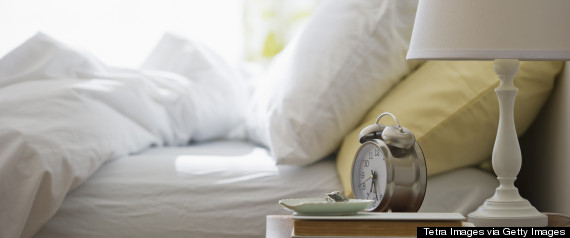Consider this the Martha Stewart equivalent of finding out Santa isn't real, or that SPF 100 really won't work. You ready for this?
A higher thread count doesn't mean you're buying a better quality sheet. Yes, higher does NOT mean better.
Believe us, we were as shocked as you. We wanted to get to the bottom of this misconception -- obviously -- so we spoke with Nancy Koltes, a luxury linens designer, and Shannon Maher, Assistant Professor at the Fashion Institute of Technology Home Product Development Program who also has a background in bedding, to try to figure out this bed linen lie.
How did the misconception come about?
Thread count, which Maher defines as "the number of yarn per square inch" seems to have started as a pretty genius marketing idea.
"[It's] an invention of the American market," said Koltes. More specifically, thread count isn't so much a "lie" as it is a falsified way to determine to the quality of sheets, especially when it's used as the only way to determine quality. Just as we attach labels like "low-fat" and "organic" to food, linen retailers extended this to luxury linens in the mid-1990s, Koltes explains. By the early 2000s, the "thread count lie" had reached new levels when the first 1,000-plus thread count linens were introduced. "It's just all promotional. Thread count doesn't represent quality," Koltes says. Nevertheless, it seems to have stuck with customers.

Well, what should we do instead?
Instead of relying on thread count alone when trying to purchase an excellent sheet, consider these other factors as well:
Fiber: According to Maher, the majority of fibers that make up sheets are cotton and you should look for a longer fiber. "Longer fiber is ideal, because when you spin the yarn, it gives it strength, which means less pilling." Egyptian cotton, which Koltes says is basically the standard of excellence, has a long fiber. Other good high-quality fiber options to look for are pima and supima, organic cotton, cotton-poplin, cotton-polyester and even bamboo.
Weave: According to Real Simple, the weave of your sheet "affects the way a sheet feels, the way it looks, its longevity, and its price." There are many different kinds of weaves, but "a percale weave is the most prominent," says Maher. "It's a balanced weave, sort of like a basket weave, and it is a crisper or cooler feel." Maher said another common choice is a sateen weave, which "has a bit of a softer feel to it, and a little warmer than percale."
Numbers aren't everything: Even if a sheet has a high thread count, that can be inflated by manipulating the sheet-making process with a low-quality construction or thread. As a general rule, buy above a 200-thread count sheet, and know that anything over an 800-thread count really doesn't matter.
To help protect consumers from inflated thread counts, the Federal Trade Commission does its best to crack down on deceptive techniques and technology designed to increase thread count, as well as deceptive advertising and marketing.

Location, location, location: Not all thread is created equal. In an interview with New York Magazine, Amanda Mettler, a textile buyer for Gracious Home, said "I can guarantee a 200 thread count from Italy is better quality than a 1,000 thread count from Pakistan." France and Italy are regarded as some of the best sheet-makers in the business, even though the fiber they use isn't always from those particular countries (such as Egyptian cotton).
Price matters: Maher is quick to remind people that "price and quality definitely go together. Bed Bath & Beyond or a Target 700-thread-count sheet is not really going to be the best quality."
Finish is everything: Most sheets are "finished" with chemical processes to keep them from wrinkling or shrinking (look for words like "shrinkage control"). Though it's nice not to have wrinkly sheets, try looking for organic cotton which should be chemical-free.
So just remember...
Buying the right sheets is a balancing act. For additional linen help, consult our handy-dandy buying guide to finding the best sheets for your budget or use this little trick to turn your bed into a luxurious hotel room.
Sweet dreams!
Related
Before You Go




